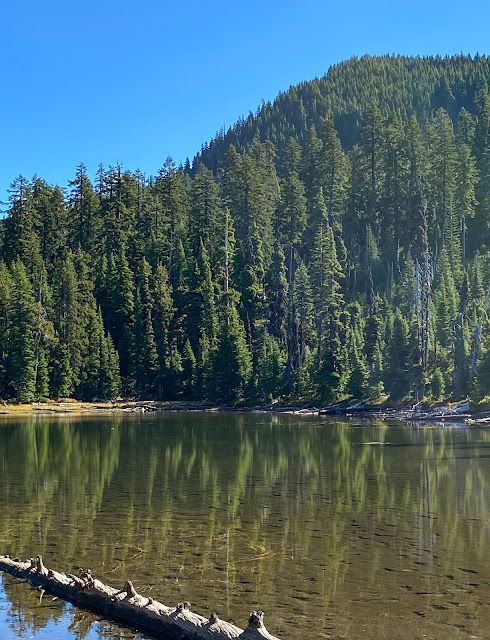In 1984, Congress approved designation of the Sky Lakes Wilderness, a 181-square-mile area in the southern Oregon Cascades. It is situated within the Rogue River–Siskiyou and Fremont–Winema national forests and contains more than 200 pools of water formed when glaciers retreated from the area. The lakes are concentrated in four main lake basins: McKee, Blue Canyon, Seven Lakes, and Sky Lakes. According to the U.S. Forest Service, Lakes Alta and Natasha in this basin were found in an EPA study of acid-rain conditions in Western U.S. mountain lakes, to have among the most chemically pure water in the world. Glaciers formerly covered this area in three glacial lake basins: Sky Lakes, Seven Lakes and Blue Canyon.
The journey begins on Seven Lakes Trail #981 which leads you through an understory filled with huckleberry shrubs. Tree cover is mostly Shasta Red fir, lodgepole pine, and mountain hemlock with whitebark pine in the higher elevations. Although rarely seen, the American three-toed woodpecker (Picoides dorsalis) reportedly uses the area according to a 1987 Draft Environmental Impact Statement. These birds are often near high elevation lakes and feed on bark beetles. The lower trail from the forest road to Frog Pond is heavily damaged from equestrian use, so this stretch is loose rock and slow going.
You will pass Frog Pond on the right, shortly after which you reach the trail junction for Devil’s Peak Trail #984. Once you reach the turn off to Devil's Peak, there is less damage and the hike is more pleasant.
After the turnoff, you will eventually enter a large block field where there is a distant view of the wilderness area. Block fields are large areas of angular rock that have been created by regular freeze-thaw activity fragmenting exposed rock. Many of the rocks are massive and the slopes are fairly steep; however, the trail is clear.
After the block field, the trail is again smooth until the immediate ascent to Devil's Peak. It is not a difficult ascent although the best views of the lakes to the north are seen from the saddle at around 7,300 feet elevation. The summit, has an incredible view in all directions including Mount Shasta, Upper Klamath Lake, Mount Thielsen, the Crater Lake rim, neighboring peaks Lucifer, Juniper, Venus and Lee. The north face of Devil's Peak is a sheer cliff.
Remnants of a former Forest Service lookout were visible during our visit. According to a August 23, 1959 story in the Medford Tribune, the live-in lookout was built in 1930 and supplied by pack train every two weeks. The person stationed at the lookout hiked two miles down the trail to neighboring Lee peak every morning for water until the pack train began hauling it in. The lookout was reportedly destroyed in 1968.






